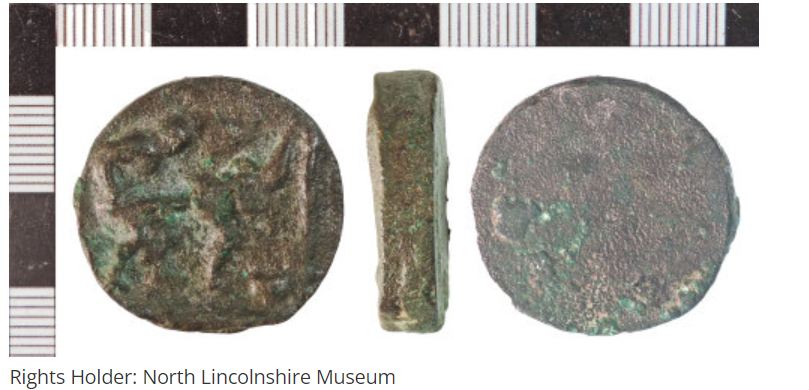Roman Sexuality and a Curious Token Found in Nottinghamshire
- Posted in:
- Archaeology
In 2015, a curious bronze object was reported to the Portable Antiquities Scheme (PAS). The PAS is managed by the British Museum and records artefacts found by members of the public. In this case, it was a coin-like token around 2.7cm in diameter and weighing 30g and found in the hinterland of a Roman town in North Nottinghamshire. It is described as having "an erotic scene depicted in relief on one side. This involves two naked figures: a young man to the left and another party of indeterminate gender to the right", while the other side is blank. It resembles a type of Roman artefact that frequently gets called a ‘brothel token’, but has the more accurate name of ‘spintria’, and may actually have little to do with brothels.

Above: Roman weight found in Bassetlaw. Image rights holder: North Lincolnshire Museum. Image taken from: Portable Antiquities Scheme (finds.org.uk) (Record ID: NLM-45C09D).
Spintriae are found across the Roman Empire and though they are remarkably similar in style and themes wherever they are found, their exact function is still unknown. One of the more reasonable interpretations is that they were tokens that were given out in return for use of a locker in public bath houses, much like lockers at the swimming baths today. This is supported by frescoes on the walls of the Suburban Baths in Pompeii that show strikingly similar scenes. The public baths at any decent-sized town in Nottinghamshire, such as at Segelocum, would likely have featured similar imagery and perhaps a locker system that used tokens.
This find from Nottinghamshire is similar to the brothel tokens but is larger and has no numerals on the reverse, so it has been interpreted as possibly being a weight. Either way, it is a glimpse into the Roman views on sexuality in the province of Britannia.
Suitability of a sexual partner in Roman times doesn’t appear to have been based on gender, but rather on a complex set of largely unwritten social factors, such as social standing of the individuals and the nature of the companionship. It is difficult to apply modern concepts of sexual orientation to the context of Rome, and Latin had no equivalent words for ‘gay’ and ‘lesbian’ for example. But homosexual and bisexual themes feature frequently in literature and art, and on objects such as the token above. Indeed, perception of an individual’s masculinity or virility could be enhanced considerably depending on the range of relationships and sexual interactions he involved himself in.
As with so many aspects of history, we know much more about how the social framework for homosexuality related to men than to women (not surprising wherever record-making and writing is primarily the reserve of men). Famed Roman poet, Ovid, claimed that women never long for other women, romantically or sexually. However, charms and poetic graffiti written by women would suggest this is a long way from reality.
When we see the vibrant explicit frescoes in the baths of Pompeii, and the intriguing snippets of graffiti from the town’s streets, it is not hard to imagine some of the same scenes at towns like Margidunum and Segelocum in Nottinghamshire, and tokens such as the one above represent a direct link between the Roman heartland and Britannia.
